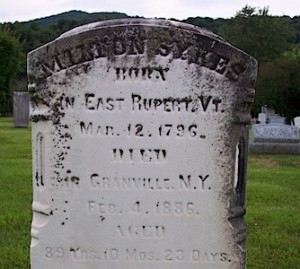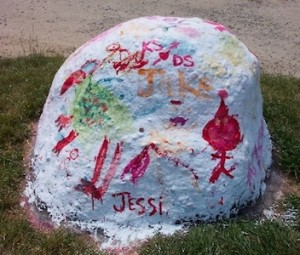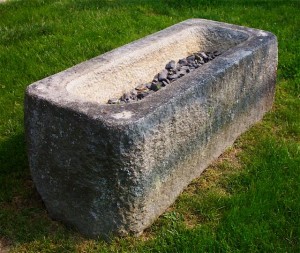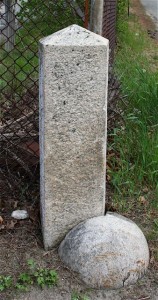
NOTABLE STONES
This class includes all objects in which one discrete stone is the object of attention, rather than a collection of them constituting a stone concentration, a stone wall, or a stone row.
FAMILY: OUTSIZED
These include large stones, often residual stones, that were too large to move prior to petroleum powered equipment.
Type: Erratic
The most familiar type are large glacial erratics, which remain in the position where they were left by the ice, and which are essentially unmodified by tools. Even if unmoved, they qualify as Notable Stones because they have become culturally relevant. Many have received names. These discrete, singular, and stable stone objects were often the sites of ceremony or celebration, for example Painted Rock at Block Island, which is alleged to be in its natural position.

Type: Placed Stone
Every large, stable (non-standing) notable stone that can be recognized as having been moved from its original place of deposition is classified as a placed stone. This type of notable stone would include the erratic moved out of the way for a construction project, a millstone leaning against an outcrop or a building, the lintel in the woods, the single-slab stone bridge, and so forth. Given the variety of cultural forms.
Arguably, the most famous is Plymouth Rock, in Plymouth MA. This is also reserved for culturally created objects that were cut from stone and moved to the site of interest.
This family of notable stones must be large (boulder-sized or bigger), elongate (prisms, columns, or blades), and oriented such that their center of gravity is much further off the ground than other, more stable positions (buried is the b-c plane). Most were inserted into excavated holes and later propped up to stand straight. They may be singular or in a group.
Standing stones are divided into two basic types, modified and unmodified. A common gravestone, qualifies as a standing stone, and may be of either type.
These do not bear marks (plain field stone). Scrape and scratch marks associated with moving the stone do not qualify. A small slab of fieldstone used as cemetery foot-stone qualifies.
FAMILY: MODIFIED
 Shaped (type), modified (family) notable stone (class). In this case, a watering trough. Harvard, MA. These singular stones are differentiated from outsized stones by being modified with tools. These bear deliberate tool marks from quarrying, polishing, cutting, engraving, etc. Any granite post or any engraved headstone is a modified standing stone.
Shaped (type), modified (family) notable stone (class). In this case, a watering trough. Harvard, MA. These singular stones are differentiated from outsized stones by being modified with tools. These bear deliberate tool marks from quarrying, polishing, cutting, engraving, etc. Any granite post or any engraved headstone is a modified standing stone.

In the photo above, the shaped stone post is a standing stone whereas the ball is not because the former has a more stable center of gravity. The latter does not. However, we reserve the subtype “standing stone” for those that are unshaped but modified by placing them upright.
Link back to the Stone Domain